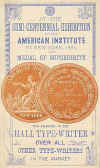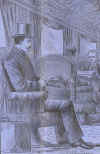|

Hall Typewriter No.1, 1885 ad

Hall Typewriter
1886 ad. The Hall could print on both sheets and rolls of
paper. This illustration shows a roll of paper.

Hall Typewriter, No. 3 (Boston), c. 1890

Typewriter ads, 1890

Sun Typewriter, introduced
c. 1885

Kosmopolit Typewriter,
1889 ad

Pearl Typewriter, 1891 letterhead (MBHT)

Pearl Typewriter, patented 1891


Odell Single Case and Double Case Typewriters, c. 1890 (MBHT)

Odell Typewriter No. 4

Kruse Typewriter

World Typewriter, late model, double-case

Pocket Typewriter, 1887

Taurus Typewriter, 1910 (MBHT)

Virotyp Typewriter, 1914

Virotyp, Paris, 1914

Mignon Typewriter, 1904

Mignon Typewriter Model 2, ad (MBHT)

Mignon type sleeves
|
Index typewriters do not have keyboards. Generally, one hand
operates a pointer that selects a letter
from an index while
the other hand depresses a lever that moves the type to the paper. The
first practical index typewriters, the American Hall Type
Writer (1881) and the German Hammonia Typewriter, were introduced in the early 1880s, several years after the first keyboard
typewriter. Index typewriters were much cheaper than keyboard typewriters during
the 1880s and 1890s, and advertisements for index typewriters stressed
this fact. Index typewriters generally sold for $10-$20, although the Hall
was $40. (See
advertisement to the left and table
below.) In 1895 the Champion Typewriter Co. advertised that over
9,000 Champions were in use in the U.S.
 The Hall Typewriter won an award in 1881.
The Hall Typewriter won an award in 1881.
Relatively inexpensive new keyboard machines declined in price from
$60 to $70 for the Caligraph No. 1 throughout the 1880s to $50 for the Crandall
during the early 1890s, $35 for the Blickensderfer No. 5 and Chicago
during the late 1890s and early 1900s, and $25 for the Commercial Visible
and Postal beginning in 1903. Also, a large supply of used and
rebuilt keyboard machines became available. As the prices of the cheapest keyboard machines fell, the demand for
index machines dropped. Eventually, the only index typewriters left on the
U.S. market were
cheap toys (e.g., the Simplex Typewriter). Serious index typewriters
(e.g., the Mignon Typewriter) sold for decades longer in Europe.
Original US Prices of Index Typewriters
Typewriter
Single-case = caps only
Double-case = upper and lower case letters |
Year |
Price |
| Universal |
1882 |
$1.50 |
| Hall (Salem in 1888) |
1883-88
unknown but later |
$40
$30 |
| Herrington |
1886 |
$5 |
| Columbia |
1886
c. 1890 |
$30
$15 & $30 |
| Sun |
1886-90 |
$12 |
| Ingersoll |
1886
unknown |
$2.25
$1.50 |
World, single-case (sc)
No. 1 Japanned, pine box, sc
No. 2 Japanned, leather-covered box, sc
No. 3 Nickeled, walnut-covered box, sc
Single-case
Double-case
Double-case |
1887-88
1887-88
1887-88
1887-88
1888-89
1888
1888-93 |
$8
$8
$10
$15
$10
$12
$15 |
Odell 1 (single-case)
Odell 1 &/or 2 Single-case
Odell 2 Double-case
Odell
Odell
Odell No. 4 |
1887
1891-92
1892-93
1895
1904
unknown |
$15
$15
$20
$12
$7.5
$5 |
| Crown |
1888-90 |
$20 |
| Morris |
1889-90 |
$15 |
| Victor |
1889-92 |
$15 |
| Merritt |
1889-93 |
$15 |
American No. 1
American No. 1
American No. 2
American No. 2
American No. 2
American No. 2
|
1889
1894
1895-97
1897, 1900-02
1902
1903-04 |
$5
$6
$8
$10
$7.95 (Sears)
$10 |
Simplex
Simplex
No. 2
Simplex
Simplex
No. 1 (toy)
No. 2 (toy)
No. 2 (toy)
No. 3 (toy)
No. 5 (toy)
|
1891-93
1895, 1897
1896
1898
1902
1907-14
1907
1914
1914
1907-14 |
$2.5
$3
$5
$3.5
$2.7
$1
$2.5
$2
$3
$5 |
| Dollar |
1891 |
$1 |
| Edland |
1892 |
$5 |
| Champion |
1895 |
$15 |
| Little Giant (toy) |
1897 |
$1 |
| Index Visible |
1900 |
$25 |
| Practical No. 3 |
1902 |
$3.55 (Sears) |
| Little Gem (toy) |
1902 |
$0.75 (Sears) |
| Coffman's Pocket
|
1902
1903, 1905 (Beach), 1909 (Mares) |
$3.90 (Sears)
$5 |
Niagara
Best
|
1902 (Rehr)
1902 |
$15
$8.95 (Sears) |
| Virotyp
|
1914 (Bliven) |
$5 |
| American Toy
|
1915 |
$0.85 |
The other
characteristic of index typewriters emphasized in advertisements
was the fact that they were small, light, and portable, and hence suitable
for being carried on trips and used in locations such as railway cars. The
Hall Type Writer weighed 7 lb., the
Victor Typewriter 5.25 lb., and the Sun Typewriter and Morris
Typewriter each 4.5 lb.

Ad showing World Typewriter
used by a man on
a train, a man at a desk with other office equipment, and a woman and boy
at parlor tables
A major downside of index typewriters was
that they were slower than keyboard machines. The American/Globe
"with practice will yield thirty or forty words per minute."
(Mares, p. 245) As a result, index machines were
not suitable for offices where a significant amount of typing was done. Some of the cheapest
index models, such as the later Simplex
Typewriter models illustrated in the
advertisement to the right, were sold at least
in significant part for use by children. The arrangement of the letters on the index may be along a
straight or curved line (Merritt, Victor), in a circle (Pocket, Virotyp), in a rectangle
(Hall, Mignon),
on a pseudo-keyboard (American Visible), or in any
of a number of other patterns. The type is usually arranged on a
single-element, which may be a wheel
(Victor, Crown), sleeve (Mignon), shuttle (American), semi-circular
element (World), straight bar (Odell), or rectangular plate (Hall,
Morris). Some machines had mechanisms for direct inking of the type
(for example, the Odell has a small ink roller) while others used inked
ribbons. An 1892 advertisement stated, "Merritt Typewriter,
An Educator for the Home and School....Indispensable to storekeepers
having limited correspondence." The Merritt was unique in using individual printer's type
pieces. In the photo at the bottom right, the type pieces are stored in a
line in a channel (see yellow dot). A knob (blue dot) is moved along the
index (red dot) to select a letter. When the knob is pressed
down, the selected type piece is lifted through a small rectangular
opening (green dot) and pressed against the paper. An 1887 advertisement
for the World Typewriter stated that 20,000 had been sold, a figure that
is difficult to believe in light of the fact that the machine was
introduced in 1887. An 1889 ad claimed 50,000 had been sold, and an
1892 ad claimed 100,000 were in use. In 1891,
Odell Type Writer claimed that 50,000 of its machine were in use. In light of the fact
that the machine was introduced in 1889 and faced many competitors, that
number is implausibly high. In any case, in 1904 Odell claimed only that
"over 30,000 in use." In 1895, Champion claimed that it had sold over
8,000 of its machines in the U.S. American claimed that it sold 15,600 machines
during 1896. The Mignon Typewriter, a German product, was "the very best
index machine that was ever made," according to Darryl Rehr (1997, p. 88).
A skilled user was able to type quickly. Rehr reports that 380,000 were made from 1904 to 1932.
|

Columbia Typewriter No. 2, advertised 1887

Victor Typewriter, c. 1889 ad (MBHT)

Victor Typewriter, 1890

Peoples Typewriter, 1891
Columbia, Victor, and Peoples photos
courtesy of Jim Gehring

Champion Typewriter, 1893

Ingersoll Typewriter, 1891 ad. This machine looks like a toy
but was advertised in business publications.

American Typewriter No. 2, 1895

Coffman Typewriter, 1903 ad

Simplex Typewriter ad for children, 1907

Hall No. 3 (Boston) Index

Merritt Typewriter, 1890 ad (MBHT)

Merritt Typewriter, carriage down

Merritt Typewriter, carriage up

American Visible Typewriter, American Typewriter Co., New York, NY, early
1900s
|
